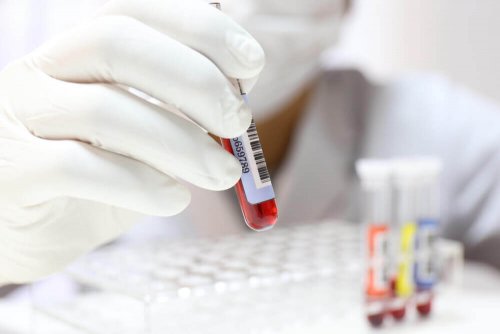How Often You Should Get Blood Tests?


Written and verified by the doctor Leonardo Biolatto
While many people consider that getting blood tests is unnecessary because they’re healthy, this is precisely the reason why they should do it. Blood tests are requested routinely to detect diseases early enough to treat them on time.
When your doctor requests routine blood tests, they do so to look for signs of certain diseases that are common to certain ages. Some blood components can become altered before symptoms manifest. That creates a huge advantage for preventive treatment and prevents future complications. On the other hand, if the patient already suffers from a chronic illness, routine blood tests allow professionals to monitor their progress and the effectiveness of the prescribed treatment.
Blood is used as a means to discover the body’s internal state due to how fast the results are obtained and how easy it is to extract blood. There are laboratories everywhere, the tests are affordable, and their usefulness has been scientifically proven.
As a rule, people who are considered healthy only need to get annual blood tests. However, patients with chronic diseases will need to have them now and then, especially at the start of treatment.
What can doctors see in blood tests?
When we talk about blood tests, we’re referring to biochemical tests on blood tissue. Blood is a liquid tissue that travels the circulatory system through the veins and arteries.
Although it’s liquid, the blood is composed of:
- Solids. The solid part of blood is also known as formed elements, such as red blood cells, white blood cells, and platelets.
- Liquids. The liquid part of blood is blood plasma.

People have blood tests to check for signs of disease and to assess the evolution of existing diseases.
Some parts of the test focus on the solid part of blood and analyze its cells. Red blood cell count, for example, determines how many of these cells are present in a given amount of blood. The number of white blood cells and platelets can also be determined. Plus, a microscope can also look at the shape of formed blood elements. Red blood cells may be large or small and have deformities or particular limits that signal the presence of disease.
On the other hand, laboratories have numerous parameters to measure the liquid part of blood. They most commonly measure the plasma concentration of sugar, creatinine, urea, uric acid, and lipids. Medical professionals can also measure the concentration of ions such as sodium, magnesium, and potassium.
Through blood tests, a person can receive information about their body’s hormonal concentration. Typically, a doctor may request thyroid function tests to determine the number of hormones produced by the thyroid gland.
Finally, there’s serology, used by laboratories to detect the presence of infectious diseases or the presence of antibodies against these diseases.
Discover more with this article: How to Improve Blood Circulation with Turmeric
Required blood tests for each age
Certain routine blood tests have been established for each stage of life. In other words, the medical professional, based on the patient’s age, will focus on what would be the most appropriate biochemical tests for them. These protocols have been set globally and nationally based on the most common ages for each disease. It’s assumed that these tests allow the detection of most diseases that cause death or alter the quality of life.
Let’s take a look at why blood tests are important at different stages of life.
Blood tests between the ages of 20 and 35
While most diseases don’t manifest at this age, annual screening is essential to prevent future complications. Diseases that are detected early will be easy to treat.
Routine laboratory tests for this age group include complete blood count, kidney function, liver condition, blood sugar, and lipid profile.
Blood tests for pregnant women
During childbearing age, women may become pregnant. Pregnancy is a particular situation that requires specific blood tests for each of the trimesters.
Routine controls during pregnancy include complete blood count at least once every three months to measure the usual, as well as infections that can affect the fetus, such as toxoplasmosis, syphilis, hepatitis B, and AIDS.
Between the ages of 35 to 55
This age group needs to have other tests done, as well, because, the prevalence of chronic diseases in the population increases after the age of forty. Doctors indicate blood tests with imaging tests, such as mammography; pathology tests, such as pap smear; and invasive tests, such as colonoscopy.
Doctors usually add tests to detect hormonal imbalances, especially in women who are going through menopause.
After the age of 60
Disease prevalence is much higher in seniors. Many people over 60 already suffer from chronic medical conditions, which is why they must have blood tests frequently.

There are specific routine tests for each age group. They can help determine if the person is developing diseases that are prevalent in their age group.
Read on to learn more: Home Recipe that Regulates Blood Sugar and Cholesterol
Conclusion
Having blood tests is part of a healthy person’s routine. If a person suffers from a disease, it’s even more necessary to undergo biochemical examination regularly to keep the disease from progressing.
After a checkup, your medical practitioner will know what tests you should get according to your age and physical condition. Remember that timely analyses can detect serious problems and prevent irreversible situations that may affect your future health.
All cited sources were thoroughly reviewed by our team to ensure their quality, reliability, currency, and validity. The bibliography of this article was considered reliable and of academic or scientific accuracy.
- Bush, B., and Encuadernación Cartoné. Interpretación de los Análisis de Laboratorio. Harcourt. Madrid, España, 1999.
- Vives Corrons J., capítulo 3, Examen morfológico de las células sanguíneas, Vives Corrons J., Aguilar J., Manual de Técnicas de laboratorio en Hematología, 4a edición, Barcelona, Editorial Masson, 2014: p.59.
- Becker, K. “Interpretación del hemograma.” Revista chilena de pediatría 72.5 (2001): 460-465.
- Wine Y, Horton AP, Ippolito GC, Georgiou G. Serology in the 21st century: the molecular-level analysis of the serum antibody repertoire. Curr Opin Immunol. 2015;35:89–97. doi:10.1016/j.coi.2015.06.009
- P., MT (2015). INTERPRETACIÓN CLÍNICA DEL HEMOGRAMA. Revista Médica Clínica Las Condes, 26 (6), 713–725. https://doi.org/10.1016/j.rmclc.2015.11.001
- Mías, C., Jürschik, P., Massoni, T., Sadurní, M., Aguilà, J. J., Solá, R., Nuin, C., & Torres, J.. (2003). Evaluación del estado nutricional de los pacientes mayores atendidos en una unidad de hospitalización a domicilio. Nutrición Hospitalaria, 18(1), 6-14. Recuperado en 31 de julio de 2020, de http://scielo.isciii.es/scielo.php?script=sci_arttext&pid=S0212-16112003000100002&lng=es&tlng=es.
- Osvaldo Padilla , MD, MPH, Texas Tech Health Science Center (2018). Pruebas de Sangre: valores normales. Merck and Co., Inc., Kenilworth, NJ, USA. https://www.msdmanuals.com/es/professional/recursos/valores-normales-de-laboratorio/pruebas-de-sangre-valores-normales
This text is provided for informational purposes only and does not replace consultation with a professional. If in doubt, consult your specialist.








